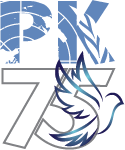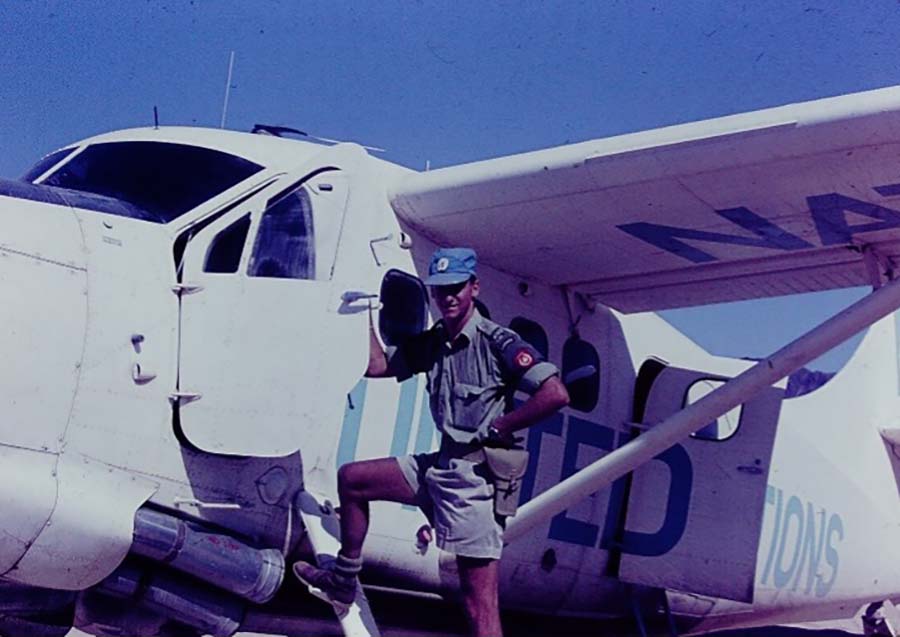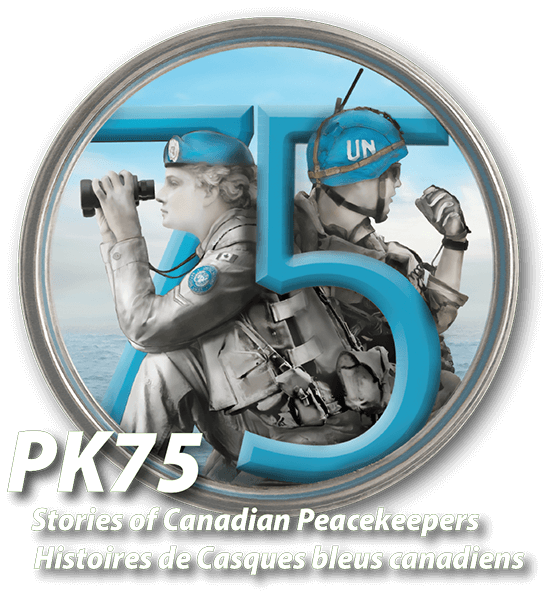


Montréal, QC, Canada
George Mayer
Current Location: Ottawa, ON, Canada
The UN compound at El Arish, Egypt was located on the south shore of the Mediterranean, 12 km from the airport. We had approximately 15 pilots flying Caribou and Otter aircraft, and our primary task was to patrol the border between Egypt and Israel. We also flew UN passengers and freight to various locations throughout the Middle East, including scheduled flights to Cairo, Beirut, and Cyprus. As an officer, I had a single room in the Officers’ Quarters which were adjacent to the Officers’ Mess where we had our meals and social gatherings. On base was a tailor shop, beach house, small base exchange, and the post office, which was a popular spot when the weekly mail arrived. Although our compound had beach access, it was seldom used, as it was littered with clumps of tar from ships that had discharged bunker oil after exiting the Suez Canal.
Shortly after my arrival, I was alone on a patrol of the Egypt/Israel border in the Otter, when I observed a convoy of UN vehicles travelling along the border. I decided to investigate by doing a very low high-speed pass directly over them. During my pass, I heard a metallic sound like “PLINK”! After checking all the instruments and finding no problems, I remained low (20 feet) and sped back to base where I learned I had amputated the top six feet of the communication jeep’s antenna with my propeller and forced the UN crews, which included a guest Israeli General (OOPS), to take cover under the jeeps. They were not amused, having had their clean UN uniforms covered with dirt and grease. The following Friday we were all invited to the army’s beer call at Rafah where I was awarded a “Distinguished F***ing Around Cross” and presented with the jeep’s antenna as a souvenir.
In 1963, a civil war had broken out in Yemen and the UN established the Yemen Observation Mission, based in the capital, Sanaa, an ancient walled city at 7400 feet elevation. Headquarters was about seven km from the airport, inside the city, and guarded by local Yemeni hired by the UN. We were housed in an historical stone building that had previously been occupied by the prince’s harem. Medical repatriation was high, as many personnel became ill from the water, which was infected with parasites.
Two pilots, a mechanic, and a UN radio officer spent alternate weeks rotating between Sanaa and one of three outposts located at Gazan (on the shore of the Red Sea), Nazran (at the edge of the Rub-al-Kali desert), and Uqd. At the outposts, the desert sand served as our runway, and two Otters were always sent on patrol in case one had an emergency. Living conditions were less than ideal with us sleeping on camp cots outside our tents to avoid scorpions, and eating boxed survival rations. When the medical officer visited, he stated “No human being should ever be subjected to the living conditions experienced by the personnel at 134 ATU Yemen mission.”
Back in Egypt, I had an unforgettable flight from Gaza to Beirut. These flights were generally quiet, as we were required to fly 30 miles off the Israeli coast until we arrived at the Lebanon border. With persistent low cloud and no navigation aids, it was challenging. On this flight, I asked my newly arrived co-pilot why he kept nervously looking out his window. He replied, “Take a look!” To my surprise, there was an Israeli Mystère fighter on our wing signalling us to head toward Tel Aviv. This was not good, as we had a full load of Arab passengers. I asked the co-pilot to observe the Mystère and report. Meanwhile, I surreptitiously reached up and slowly pulled back the Caribou’s throttles. Within a few seconds there was a very loud bang that sounded like a fighter jet’s afterburner. The co-pilot reported that the Israeli fighter had disappeared straight up, never to be seen again! The Mystère could not match the slow speed of our Caribou and had obviously entered a stall. The pilot had powered his way out of it and probably needed to change his shorts after landing!
Biography
I always wanted to fly! I was born in Montréal October 5, 1940, and from an early age showed a keen interest in aviation, making countless paper airplanes and gradually progressing to models. As a young teen, I would take the streetcar out to Cartierville airport to stand by the fence and watch the aircraft. A high school friend mentioned Air Cadets, and I joined No.1 West Montréal Squadron in 1956.
The following summer, I signed up with the RCAF Auxiliary and qualified as an air frame technician. A year later, I was awarded the Air Cadet Power Flying Scholarship and earned my private pilot licence in a Cessna 172. In 1959, I was selected for the Air Cadet International Exchange visit to the UK, and later that year I was accepted by the RCAF for pilot training. After completing courses at Centralia, ON, Penhold, AB, and Portage la Prairie, MB, I received my pilot’s wings in 1961. My first job was as a pilot with the Air Navigation School in Winnipeg. It was a great job for a young pilot to gain valuable experience and flying time.
Since I was looking for adventure, I volunteered to serve with United Nations in the Middle East. The spring of 1963 found me at Trenton, ON, training on the DeHavilland Caribou and Otter aircraft in preparation for my posting to El Arish, Egypt. I began flying there in June 1963 and after three months was sent to the UN Observation Mission Sana, Yemen, on a six-month posting before returning to El Arish to complete my required time there. Thus, with back-to- back postings, I was awarded medals for both the UN Emergency Force (Egypt) and UN Yemen Observation Mission.
Before returning to Canada, I used my leave to travel and visit relatives and friends in Germany, Switzerland, and Norway. I returned to Trenton after a year out of the country and spent the summer flying there before transferring to 412 Squadron in Ottawa in September,1964. My three plus years in Ottawa proved to be an interesting time. Our task was to fly VIPs and visiting Heads of State, quite a change from my UN experience! While in Ottawa I met my wife, Joy Hartley, a teacher at RCAF Rockcliffe and we married in August 1967.
After completing courses to become a flying instructor in 1968, I was posted to CFB Borden, ON, to instruct at the Primary Flying School and in 1970, the school and I relocated to Portage la Prairie. Another two years and I was back to CFB Borden as Executive Assistant to the Base Commander. My duties included serving as President of the Borden Flying Club and instructing Air Cadets on the flying scholarship program. This required me to upgrade my civilian flying and instructor licences, which would come in handy later in my career.
In September 1974, I was posted to Greenwood, NS, to fly the Argus (CP07). This was a challenge as the Argus was the largest aircraft I had flown, and I was not used to flying as low as 200 ft over water searching for and tracking submarines. I came to love this kind of flying and being a Crew Commander responsible for a crew of 17.
In 1980, the Argus was retired, and it was time to move my family back to the Ottawa area. Unfortunately, this meant I would be flying a desk at DND Headquarters, which was not nearly as exciting or rewarding as flying the Argus. In 1982, I accepted a position at Transport Canada in Ottawa as a Civil Aviation Inspector. I left the RCAF after 24 wonderful years and continued flying in my new position. At Transport Canada I completed inspections for Canadian pilot efficiency in Canada, the Middle East, and Africa for 13 years until I retired in 1995.
At retirement, I had flown for 37 years logging 10,865 hours in 26 types of aircraft. Since then, I have enjoyed restoring vintage motorcycles, RV camping, fishing trips, photography, and spending time with our two daughters, their spouses, and our four grandchildren. My wife and I still like to travel and between us have visited six continents and 69 countries. At time of writing, I am living in Ottawa, and am active in several Veterans’ organizations, and as a tour guide at Vintage Wings of Canada.

Flight planning, Yemen, 1963.

Flying Officer Mayer with DeHavilland Otter, Egypt, 1964.


